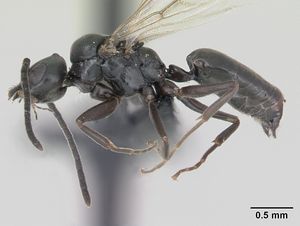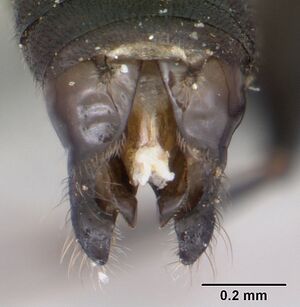Technomyrmex curiosus
| Technomyrmex curiosus | |
|---|---|

| |
| Scientific classification | |
| Kingdom: | Animalia |
| Phylum: | Arthropoda |
| Class: | Insecta |
| Order: | Hymenoptera |
| Family: | Formicidae |
| Subfamily: | Dolichoderinae |
| Genus: | Technomyrmex |
| Species: | T. curiosus |
| Binomial name | |
| Technomyrmex curiosus Fisher & Bolton, 2007 | |
The type material was collected from "native grass."
Identification
Bolton (2007) - A member of the T. albipes complex in the Technomyrmex albipes group. Apart from the tramp species Technomyrmex albipes, and the as yet unrecorded Technomyrmex vitiensis, this is the only Madagascan Technomyrmex species that has setae present on the frontal carinae but absent from the head posterior to this. T. curiosus is easily distinguished from both these tramps by its complete lack of mesosomal setae and the general absence of setae from the first and second gastral tergites.
At first glance curiosus looks like a rather stocky specimen of Technomyrmex difficilis that has lost all of its mesosomal setae and almost all of its gastral setae. Apart from the greatly reduced number of setae, other obvious differences from difficilis include the short, compact mesosoma in curiosus, where the promesonotum is almost as broad as long (DTI 108 - 113, as opposed to DTI 127 - 135 in difficilis), and the shape of the propodeum in profile, as described above, which is different from the more angular shape seen in difficilis
Keys including this Species
Distribution
Latitudinal Distribution Pattern
Latitudinal Range: -19.006727° to -19.006727°.
| North Temperate |
North Subtropical |
Tropical | South Subtropical |
South Temperate |
- Source: AntMaps
Distribution based on Regional Taxon Lists
Malagasy Region: Madagascar (type locality).
Distribution based on AntMaps
Distribution based on AntWeb specimens
Check data from AntWeb
Countries Occupied
| Number of countries occupied by this species based on AntWiki Regional Taxon Lists. In general, fewer countries occupied indicates a narrower range, while more countries indicates a more widespread species. |

|
Estimated Abundance
| Relative abundance based on number of AntMaps records per species (this species within the purple bar). Fewer records (to the left) indicates a less abundant/encountered species while more records (to the right) indicates more abundant/encountered species. |

|
Biology
Castes
Male
Images from AntWeb
      
| |
| Paratype of Technomyrmex curiosus. Male (alate). Specimen code casent0070364. Photographer April Nobile, uploaded by California Academy of Sciences. | Owned by CAS, San Francisco, CA, USA. |
Nomenclature
The following information is derived from Barry Bolton's Online Catalogue of the Ants of the World.
- curiosus. Technomyrmex curiosus Fisher & Bolton, in Bolton, 2007a: 46, fig. 25 (w. w-q intercastes. m.) MADAGASCAR.
Unless otherwise noted the text for the remainder of this section is reported from the publication that includes the original description.
Description
Worker
Holotype. TL 2.9, HL 0.70, HW 0.68, SL 0.61, PW 0.46, WL 0.80. Indices: CI 94, SI 97, 01 24, EPI 71, DTI 109.
Frontal carina with 2 setae: in profile the first above the torulus and the second at about the level of the anterior margin of the eye; both are much shorter than the maximum diameter of the eye. Posterior to this the dorsum entirely lacks setae. In full-face view median portion of anterior clypeal margin evenly shallowly concave; posterior margin of head with a slight median indentation; sides of head evenly convex. Eyes of moderate size and located well in front of mid length; in full-face view outer margins of eves just fail to touch the outline of the sides. Dorsum of mesosoma and propodeal declivity entirely lack setae. With mesosoma in profile the mesonotum is rounded and evenly convex. Metanotal groove in profile not Impressed; metathoracic spiracles abut the metanotal groove in dorsal view. Propodeum in absolute profile does not have differentiated dorsal and decIivitous surfaces. Instead a single evenly rounded surface is present, the dorsal portion of which is very short and rounds evenly, without trace of an angle, into the declrvity proper. Gastral tergites 1 - 2 lack setae (see below) but tergites 3 - 4 each have sparse, scattered short setae present. Head, mesosoma, petiole and gaster black. Coxae and femora about the same colour as the mesosoma, tibiae and tarsi slightly lighter.
Other worker. TL 2.6 - 2.9, HL 0.68 - 0.72, HW 0.64- 0.68, SL 0.60 - 0.64, PW 0.44 - 0.48, WL 0.72 0.83 (10 measured). Indices: CI 94 97, SI 90 - 97, 01 24 26, EPI 68 - 76, DTI 108 113.
In most workers the mesonotum is evenly curved, but in some it has a small posterior declivity. These seem intermediate between true workers and the most worker-like intercastes where the mesonotum is slightly expanded posteriorly. The vast majority of workers have no setae on the first and second gastral tergites but one or two have a single pair on one or both of the sclerites. This feature seems most prevalent in intercastes and it may be that apparent workers with such setae are in fact extremely worker-like intercastes. Colour of the tibiae and tarsi is somewhat variable; frequently the two are of similar colour but the tarsi may be lighter. Betsch material, a single specimen from the same locality as the type-series, is brown and had probably not attained its full adult colour.
Type Material
Holotype worker, Madagascar: Provo Fianarantsoa, P.N. Andringitra, 2100 m., 22°10.84' S, 46°54.04 'E, lo,iv.2006, native grass, BLF 13814, 0070366-RES (Fisher et al.) (California Academy of Sciences).
Paratypes. 7 workers with same data as holotype; 1 intercaste with same data but BLF 13816, 0070363-RES; 5 workers, 2 intercastes, 1 male with same data but BLF 13817, 0068743-RES; 7 workers with same data but BLF 13818, 0068745-RES; 1 worker with same data but BLF 13820, 0070365-RES; 8 workers, 3 males with same data but BLF 13821, 0070364·RES (CASC, The Natural History Museum).
[A number of specimens remain in alcohol for each of these series, in CASC. They should also be included as paratypes.]
References
- Bolton, B. 2007. Taxonomy of the dolichoderine ant genus Technomyrmex Mayr (Hymenoptera: Formicidae) based on the worker caste. Contributions of the American Entomological Institute. 35(1):1-149.

